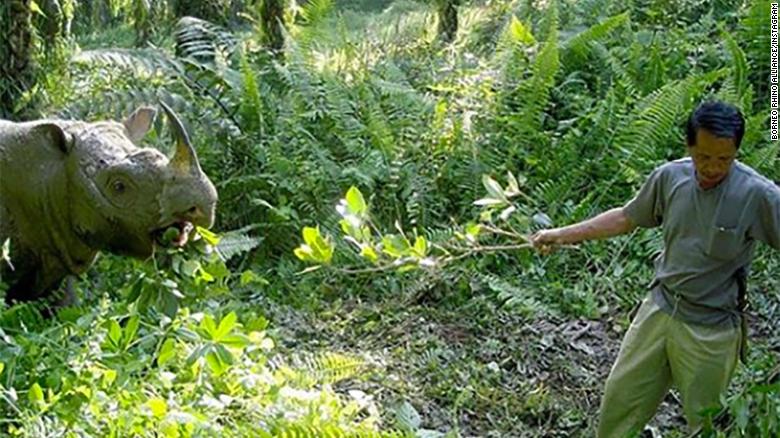Scientists seek to recover extinct rhinoceros breed 0:41
(CNN) - Imam, the last Sumatran rhino in Malaysia, died last November, bringing the endangered species one step closer to extinction.
Now Malaysian scientists hope to use tissues and cells from Magnet and other dead rhinos to restore the population.
The project, carried out by a team from the International Islamic University of Malaysia (IIUM), focuses on stem cell technology and in vitro fertilization. The process is similar to cloning technology in that it aims to deliver a new baby using cells from old rhinos, said Dr. Muhammad Lokman Bin Md. Isa, one of the lead researchers.
"Before the three rhinos (the last survivors in Malaysia) died, we got their cells and the cells are still alive, so I am very confident," Dr. Lokman told CNN. “If you don't have cells, or if we just have tissue that is no longer alive, we can't do anything with that. We can only put it in a book or museum. But now we have a living being that we can use.
Here's how the process works: In collaboration with the Borneo Rhino Alliance (BORA), the researchers collected cells and tissue from the last three Sumatran rhinos at the BORA sanctuary, including Imam, before they died.
Cells come from rhinoceros' hearts, lungs, brains, and kidneys. Fundamentally, the team collected stem cells - basically raw material from which cells with specialized functions can be generated.
LOOK : Scientists seek to recover an extinct breed of rhinoceros with stem cells
There are then two possible approaches. The first is to develop these stem cells into an egg and sperm, to create an embryo that will be implanted into a surrogate mother. The surrogate is likely to be another rhino, whether it is a Sumatran rhino from another country or from another species.
The second method is to take the egg from a surrogate animal, remove the nucleus, and join it with the somatic cell of a Sumatran rhinoceros. This technique was used to clone Dolly the sheep in 1996.
Lokman and his colleagues are trying both ways.
A protected Sumatran rhino in a Borneo region near Lahad Datu, Malaysia, in October 2013.
Because stem cells self-replicate, the team has a decent pool and can try different methods to see which one works best.
The team is still in the preliminary stages; They then need to analyze the cells to create a genomic database, differentiate the stem cells, and work with zoos and conservation areas to find a suitable surrogate female. There are several ways this could go wrong; fertilization could fail, and even if it doesn't, the pregnancy could fail once the embryo is implanted.
But there are signs of hope in similar projects around the world. A conservation in Kenya is home to the only two remaining northern white rhinos in the world, Fatu and Najin, both female. Last year, scientists successfully fertilized in vitro embryos collected from the two remaining females with sperm from dead males, which was celebrated as a major step forward in saving the subspecies.
The race against extinction
Imam died at BORA's Borneo Rhino Sanctuary last year, where she had been kept and cared for since her capture in 2014. She was 25 years old and had cancer, which was beginning to cause her pain because a tumor was putting pressure on her bladder. .
His death came months after Tam, Malaysia's last male Sumatran rhino, died after suffering organ failure. Conservationists expected the breeding between Tam and Iman.
There are several factors that complicated these efforts; female rhinoceros in the reserve turned out to be infertile, and plans to establish an international breeding collaboration ultimately fell through due to "a series of incidents, some socio-political, some biological and some simply unlucky," said Susie Ellis, executive director from the International Rhino Foundation, in a statement following Tam's death.
Tam was the last male Sumatran rhino left in Malaysia before he died in 2019.
Sumatran rhinos, the smallest species of rhino in the world, are classified as critically endangered by the World Wildlife Fund. The International Rhino Foundation (IRF) estimates that there are fewer than 80 alive in the world.
With Imán's death, the IRF declared the species extinct in the wild in Malaysia; the remaining rhinos are scattered throughout Indonesia and Thailand.
The population decline was initially due to poaching for its horns, which were coveted as ingredients in traditional Asian medicine. Later, it was exacerbated by habitat fragmentation and human encroachment on the environment, which prevent rhinos from gathering and reproducing.
LEE : Scientists created embryos of northern white rhinoceros to save them from extinction: there are only two left in the world
The international trade in rhinoceros horn has been prohibited since 1977, regulated by the Convention on International Trade in Endangered Species of Wild Fauna and Flora (CITES), but individual countries determine their own laws that allow or prohibit its sale at the national level, according to Save The Rhino.
Now only five species of rhinoceros remain in the entire world and all are threatened. Some subspecies have already disappeared; The western black rhinoceros, native to West Africa, was declared extinct in 2013 due to poaching. The last male northern white rhino died last year, prompting scientists to try in vitro fertilization with Fatu and Najin.
Cloning



/cloudfront-eu-central-1.images.arcpublishing.com/prisa/WWFMH3RJQFHGDLP4L4JLWOGC6Y.jpg)







/cloudfront-eu-central-1.images.arcpublishing.com/prisa/KMEYMJKESBAZBE4MRBAM4TGHIQ.jpg)



